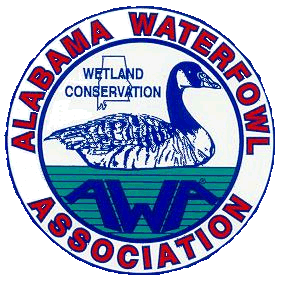

Alabama Waterfowl Association
Phillips Wildlife Demonstration Area
Work Starts On The Blind For Physically Challenged Waterfowlers
Water Control Structure and Corn !

Left to Right: Kim Pilarski, TVA Wetlands Biologist; Jerry Davis, CEO AWA; Mitch Adams; President, AWA; Jim Schrenkel, Manager of Skyline / Martin Wildlife Management Area, Alabama Department of Conservation and Natural Resources; Rick Roden, Executive Director, Scottsboro / Jackson County Chamber of Commerce. The group was looking over and discussing the planned restoration of the 80 acres just purchased by AWA.
Official Statement from TVA
� Mud Creek is a heavily impacted watershed which is on the State of Alabama's "303d" list of impaired waters. This means that the water is polluted to such a degree that it does not meet certain water quality criteria for intended uses.
� Mud Creek is also currently one of only two watersheds adjacent to Guntersville Reservoir rated "poor" by TVA's Resource Stewardship program for low water quality conditions.
� The water quality problems are low dissolved oxygen and excessive sedimentation due to non-point source runoff related to land uses in the watershed.
� Removing the land from agricultural production and restoring wetland and upland habitat will eliminate agricultural run-off and improve water quality conditions in Mud Creek
� Wetlands act as "natures kidney" by filtering and holding sediment and excess nutrients (e.g waste from cattle, dirt washed off fields during rain, fertilizers, pesticides and herbicides); this results in improved water quality in Mud Creek and ultimately in the Tennessee River itself
� Restoring wetlands and uplands on the property will have the added benefit of increasing wildlife and waterfowl habitat in the area. Once the restoration project is complete, the land will be transferred to the state of Alabama for incorporation into the wildlife management areas/refuge system for public recreation and wildlife habitat benefits.
� TVA is working with AWA on this project because AWA has demonstrated a tremendous commitment to protecting, enhancing, and creating wetland habitat in Alabama.
� Alabama has lost over 50% of its original wetlands, thus this project and the involvement of AWA will help in long-term restoration of wetland functions in the region.
Kim Pilarski Wetland Biologist Tennessee Valley Authority
Official Statement Alabama Waterfowl Association
� This project will be an increase in habitat which is very timely since the U. S. Fish and Wildlife Service is predicting a fall flight in excess of 100 million ducks. This exceeds the goals of the North American Waterfowl Management Plan. This will be the largest fall flight of migrating ducks since the fifties. Alabama has lost many acres of habitat and farm acreage due to the rapid development in the Tennessee River Valley (TRV). This restoration project will provide more habitat and offset the loss.
� The migrating birds that winter and fly through the TRV depend on the planted food plots the sportsmen and wildlife managers provide, and the left over grain (corn, soybeans, and milo) from farmer's harvested fields. The waterfowl during the colder months they are in this area (December and January) depend on the grain to replenish their energy to endure the cold weather and for their journey back north in the spring. If the migratory birds are under nourished due to lack of habitat, or food source they do not reproduce as well. Ducks will feed in dry fields, but prefers flooded grain and natural wetland vegetation. Ducks digestive system requires them to have a lot of water to perform the digestive cycle.
� When AWA completes restoration this will create a filter bank, which will return many of the wetland functions to the land. Removing many of the pollutants, recharge the underground aquifers, and provide a net increase in local and migratory bird habitat in this area.
� This project took this acreage out of adverse development forever. A public water supply was completed a few days ago and is now available at this site. This would have made this land very desirable for residential or commercial development adding to urban sprawl.
� TVA and AWA are looking at the best use of this property to benefit the public. AWA will use this project as a conservation outreach tool, with a focal point on getting more youth, physically challenged people and minorities interested in conservation that benefits all people, fish, plants and wildlife.
� TVA and AWA by working together on this project, is providing a healthier environment, quality of life and multi-use recreational opportunities in the TRV, with the added benefit of providing wildlife habitat.
Jerry D. Davis, CEO
Whom should the people thank for this project? TVA, especially Mr. Ralph Jordan, Jr. (son of the late state of Alabama hero and Auburn's football coach, Ralph "Shug" Jordan), Ms. Kim Pilarski, Mr. Scott Atkins, all Alabama Waterfowl Association's members, Senator Richard Shelby, Governor Don Siegelman, State Representative John Robinson and Mr. Rick Kochevar.